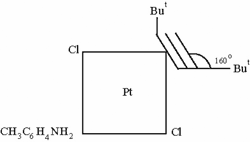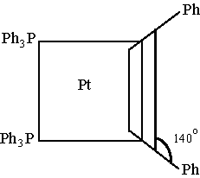by, Sithamalli K. Balasubramanian - Ph.D.
Triple Bond: Our model predicts two possibilities for the triple bond. One is the classical triple bond of face sharing tetrahedra (18a) with linear substituents. The second triple bond is the b-b, b-b, q-q type called the ‘benzyne’ triple bond (18b), having the approximate geometry of the van’t Hoff double bond and capable of exhibiting cis, trans, isomerism. The benzyne bond is the stabilising vibrational mode for aromaticity. The bond distance and the bond angle would be difficult to predict. We record that there seem to be two types of benzyne triple bonds: one that is stationary and another that tends to swing between the benzyne bond and the single bond. The first is represented by the ‘vertical’ acetylenic complex (19). The bidentate acetylene complex is shown in (21) The C C bond distance here is similar to that in acetylene (123.5pm) and the bond angle for the substituents is 165º {ref.26}. The bond angle variation in the complex system is shown in (20) The first figure (20a) is for the ‘stationary’ bond.

Fig.18a - Classical triple bond with face sharing tetrahedra.

Fig.18b - Benzyne triple bond b-b, b-b, q-q type.

Fig.19 - Vertical acetylenic complex.

Fig. 20a - Stationary
benzyne bond.

Fig. 20b - Swinging benzyne bond.
The swinging benzyne bond, shown in (20b), has a bond length (137-140) closer to the average of the single bond (154pm) and triple bond lengths (120pm) and a bond angle of 137º. The acetylenic carbons are nominally pentavalent {ref.27}.
A feature of the swinging benzyne bons is that one b-surface becomes free, part of the time during the swing and could linkup with another metal atom to produce a complex of the type (22) {ref.28}.

Fig.21 Bidentate benzyne bond.

Fig. 22 Cobalt complex having cis – benzyne.
The linear and angular carbyne complexes are shown in (23 & 24) {ref.29,30},
![]()
Fig. 23 - Linear carbyne complex.

Fig. 24 - Angular carbyne complex.